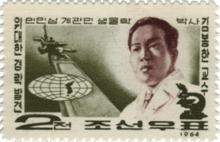Kim Bong-han
| Korean spelling | |
|---|---|
| Chosŏn'gŭl | 김봉한 |
|
Revised Romanization |
Gim Bong-han |
|
McCune- Reischauer |
Kim Bonghan |
Kim Bong-han (* 1916 in Seoul , † probably 1966 in North Korea ) was a North Korean medic. At the beginning of the 1960s he postulated the existence of a so-called “Primo Vascular System” (abbreviated PVS, German for “Primo Vascular System”).
Life
Kim grew up as the son of a pharmacist in Seoul. After graduating from Bosung High School in Seoul in 1934, he studied medicine at Kyungsung University (since 1945, after the Japanese had left Korea Seoul National University), which he successfully completed in 1940 and then accepted a position there in the physiology department . In 1945 or a year later, Kim was appointed assistant professor at Seoul Women's Medical College Hospital, which at least in later years was affiliated with Korea Seoul National University. During the Korean War , Kim came to North Korea without his family, although there is no evidence that he was a follower of communist ideology , especially since he had previously been a member of the Korean Democratic Party. He may not have thought that Korea would be divided when he moved. In North Korea he worked as a physiologist and published, for example, a paper in 1957 on the reactions of the skeletal muscles to temperature changes. During this period he was also involved in setting up a medical research center, which should be of the highest quality, and became head of physiological lectures at Pyongyang Medical School. From 1956, the government also promoted research in Chinese medicine with a five-point plan. In 1966 Kim disappeared without comment.
Primo vascular system
The “Primo vascular system” is a third vascular system postulated by Kim, which cannot be assigned to either the blood vessel system or the lymphatic system . It should differ anatomically and in relation to the fluid it contains (“primo fluid”) from the blood and lymphatic system and consist of vessels (“primo vessels”) and nodes (“primo nodes”). It forms a dense network that runs through the whole body and runs freely, yet occasionally following the pathways of nerves, blood and lymph vessels.
There is no recognized evidence for the existence of such a system.
On August 18, 1961, Kim went public for the first time with his discovery of a supposedly new vascular system. At that time he called his discovery the Kyungrak system and believed to have found an equivalent for the ancient system of meridians . Other workers who had moved from the south to the north of Korea were also involved in his work. In the following years he published numerous other works that received international attention.
The Communist Party enthusiastically celebrated Kim's results and saw them as a sign of the independent spirit of their nation. This not only earned him the personal congratulations of the then ruler Kim Il Sung , but also his own research institute. During this time the terminology changed and the Kyungrak system became the Bonghan system. It is unclear whether this name change, which is unusual for Korean standards, was initiated by the government or by Kim himself. The North Korean leadership saw him in a row with the Nobel Prize winner Ivan Petrovich Pavlov and his groundbreaking discoveries and imported the most modern technology for him. Park Jung Sik, the daughter of the second most powerful man in North Korea at the time, Park Keum Chul, also worked for Kim. Kim's last known publication was in 1965.
In 1966 the health system in North Korea was restructured. In this context, senior officials from health policy and medical research disappeared. Since then there has also been no trace of Kim and his employees.
His work was replicated only once abroad in the 1960s and was rejected by the Medical Society of Russia in 1967. From 2000 they were resumed. His Kyungrak system (later the Bonghan system) was renamed the Primo vascular system in 2010.
Individual evidence
- ↑ a b KA Kang: Historical observations on the half-century freeze in research between the Bonghan system and the primo vascular system . In: J Acupunct Meridian Stud. , 2013 Dec, 6 (6), pp. 285-292, doi: 10.1016 / j.jams.2013.07.004 , PMID 24290792 .
- ↑ Miroslav Stefanov, Michael Potroz, Jungdae Kim, Jake Lim, Richard Cha, Min-Ho Nam: The Primo Vascular System as a New Anatomical System. Journal of Acupuncture and Meridian Studies, Volume 6, Issue 6 (December 2013) pp. 331–338. doi : 10.1016 / j.jams.2013.10.001
| personal data | |
|---|---|
| SURNAME | Kim, bong-han |
| BRIEF DESCRIPTION | North Korean researcher |
| DATE OF BIRTH | 1916 |
| PLACE OF BIRTH | Seoul , South Korea |
| DATE OF DEATH | uncertain: 1966 |
| Place of death | North Korea |
